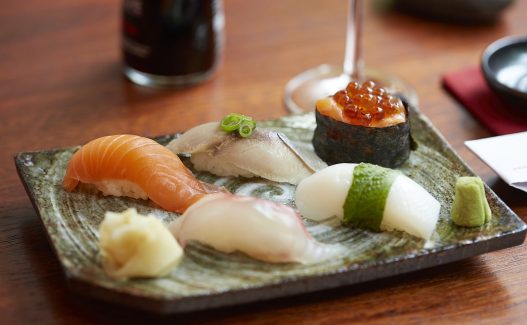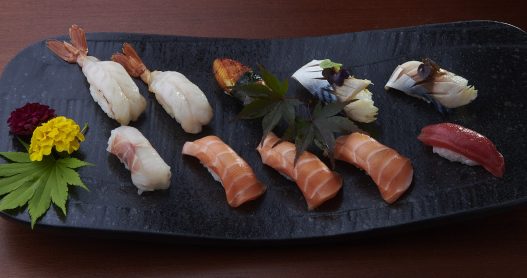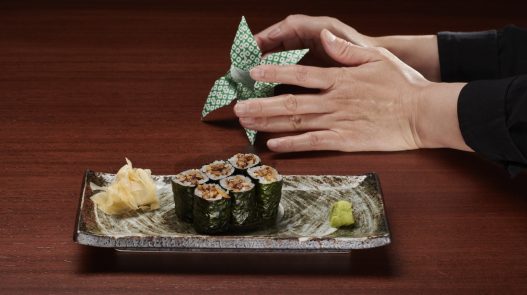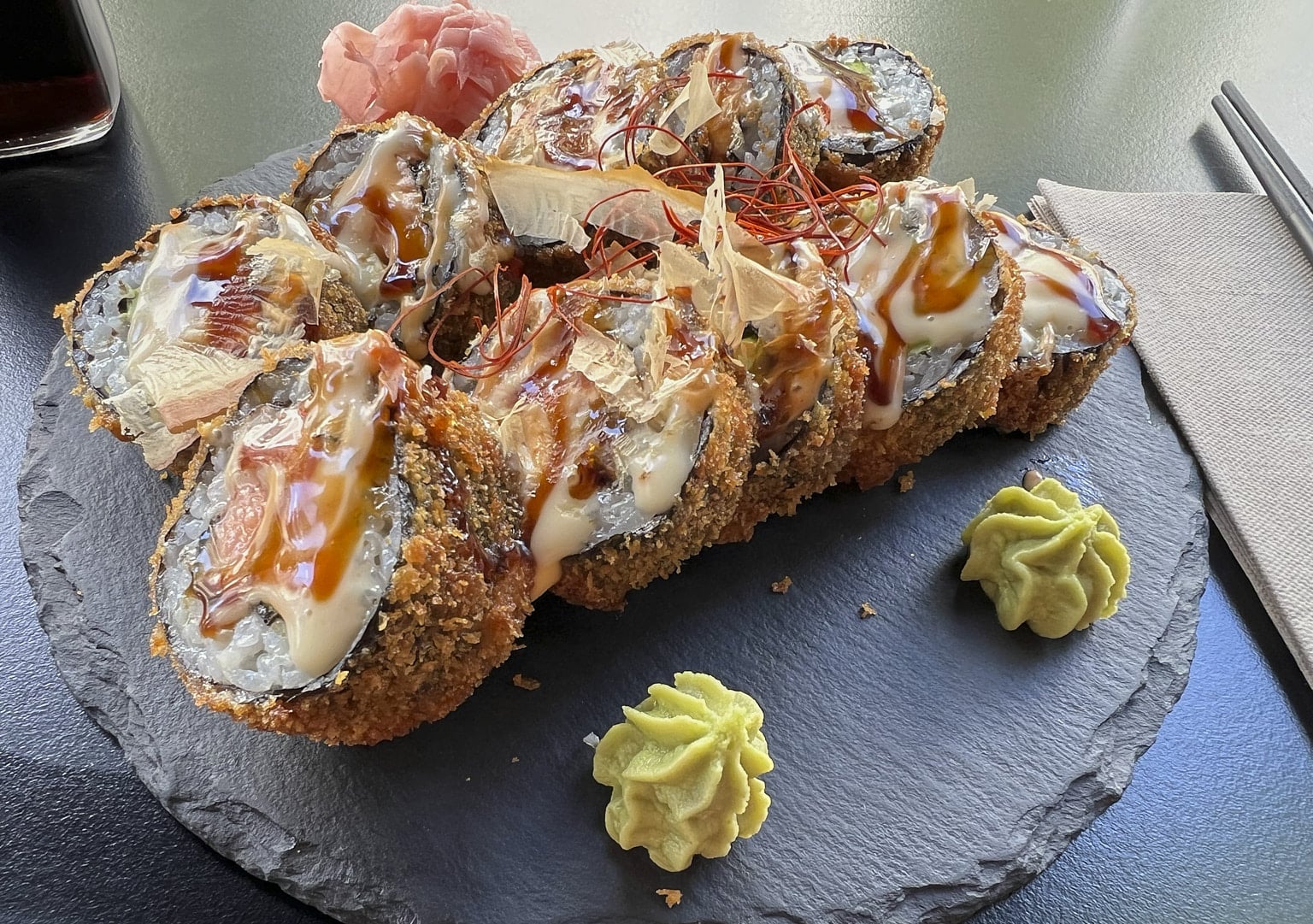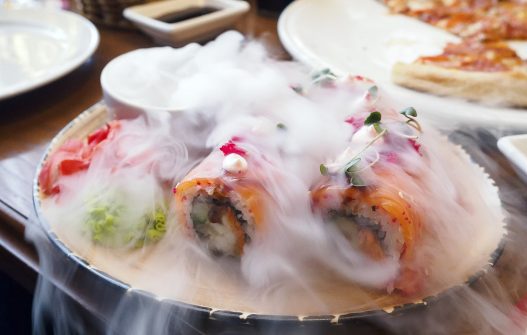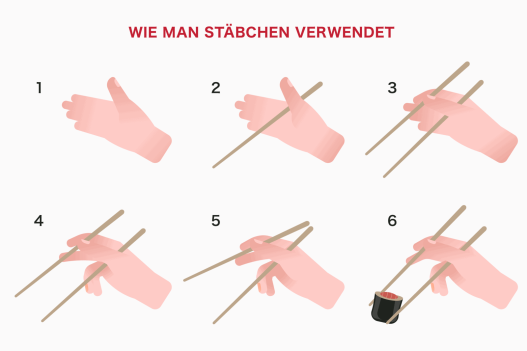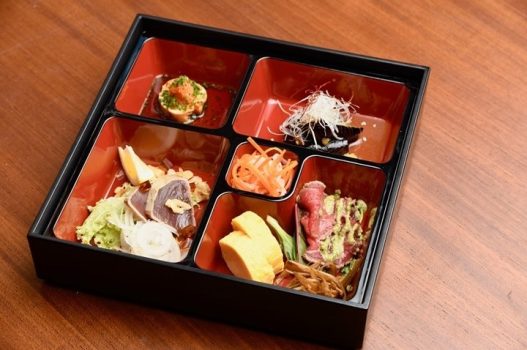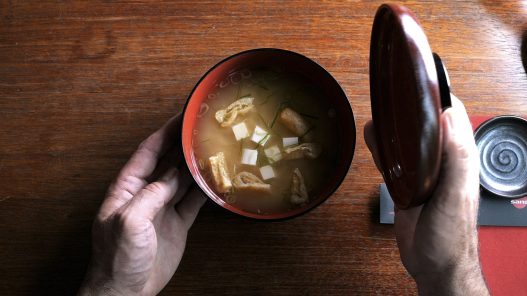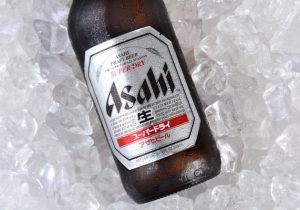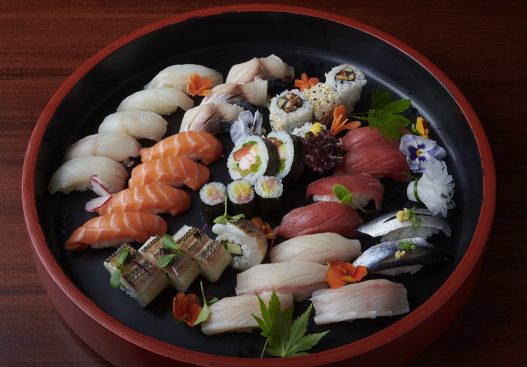What is sushi?
How is sushi traditionally prepared? What different types of sushi are there and what cultural significance does sushi actually have in Japan?
In this article you will learn all about Japanese indulgence.
What is sushi?
Sushi is an exquisite Japanese specialty in which Rice is seasoned with vinegar, sugar and salt and artfully served with raw or cooked Fish as well as Vegetables is combined.
These ingredients are often used for the familiar roll shape in Nori (seaweed) and represent a harmonious fusion of taste, texture and visual aesthetics. Sushi is often served with soy sauce, wasabi and pickled ginger.
There are various forms of sushi, including Maki, Nigiri, Sashimi, Temakiand other variations such as Uramaki and Oshizushi.

Discover sushi
Authentic cuisine & insider secrets
since 2006
Sushi - seemingly a quick snack on every street corner, in almost every city in the world by now, and at the same time an expression of the highest Japanese culinary art and aesthetics.
In our Restaurant sansaro in Munich Since 2007 (and previously from 2009 - 2009 in the SUSHIYA BENTO STORE in Munich's city center) with a depth and intensity of sushi & Japanese cuisine that is rare outside of Japan.
Here you will find all the information about the Japanese superfood, its development and the different types of sushi. Get amazing insights into our experiences with German sushi restaurants.
Where does sushi come from?
Sushi is coming from Japan. It is a branch of classic Japanese cuisine, called Washokuwhich are known as World cultural heritage is recognized.
Who invented sushi?
Sushi is believed to have originated in the Mekong Delta in the 4th century BC and spread to Japan via China. However, the modern form of sushi has only been documented in Japan since the 19th century.
The people of this fascinating island kingdom are known for their traditional Crafts to perfection over generations. In Japan, culinary delights are at once culture, art and craft, philosophy and perhaps even medicine.
The The depth to which sushi is prepared in Japan is often unimaginable for the Western world. Yet sushi rolls, just like many other "typical Japanese" dishes today (think ramen, udon or tempura). again and again Influences from abroad recorded.
Why is sushi called sushi?
Sushi probably derives from the old Japanese term Su-Meshi which means "sour" or "acidic". Su (酢) refers to rice vinegar, which is used to sour the rice, while meshi (飯) means rice or meal.
Sushi is therefore always a mixture of mildly leavened rice and various ingredients such as meat, fish or egg, in different shapes and sizes.
The rice specially prepared for the small snacks is still called su-meshi (酢飯), vinegar rice.
Would you like to delve deeper into the history of sushi? In our blog article "Where does sushi come from?" you can find out more about the story of raw fish and sour rice.
Varieties and shapes

Maki & Makimono
While in Europe sushi is mainly known as small rolls (Japanese: Makimono), in Japan they tend to be home cooking.
MakiThe rolls, as they are called in Japanese, are cut into the classic shapes Hosomaki, Chūmaki and Futomaki subdivided. There are also Uramakiwhich are particularly popular abroad - i.e. outside Japan.

Nigiri & Gunkan
In restaurants and on special occasions, Japanese people tend to enjoy the shapes Nigiri and Gunkan.
Nigiri is more or less the classic Japanese version, also known as nigiri. Edo Mae Sushi.
Gunkan are sometimes referred to as gunkan maki. However, they actually belong to the nigirizushi family. This is because the shape, like the name, from the shape of the Japanese battleship derived.
The nori sheets are placed around the outside of the rice ball, but it is not not rolled.
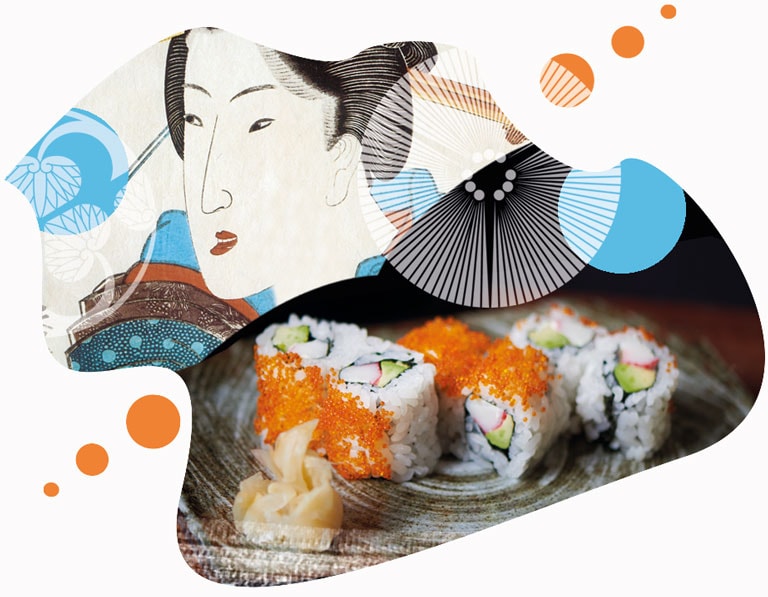
Uramaki, Inside-Out & Others
More modern are special forms such as the Uramakithe so-called Inside-Out-Rollswhich, according to legend, come from California. There are also various special forms that are rather rare abroad, such as Kakushisushi, Bosushi, Oshizushi and so on.
Incidentally, the small, practical snack on the hand is called Temaki (hand roll). And it is now also known in the West.
Also available Vegetarian or vegan sushi? Does sushi have to be raw? You can find answers to these and many other questions in our comprehensive overview of the different types and forms of sushi.
Sashimi

Sashimi - Not sushi, but close!
Sashimi is close to sushi. But there is one major difference, which is why Sashimi officially not sushi is. Because sashimi contains no rice.
Sashimi is part of many dishes in Japanese cuisine that have nothing to do with classic sushi. With Kaiseki For example, a first-class menu that consists of many small courses and is part of Japanese haute cuisine, there is almost always one course with sashimi, almost never one with sushi.
The preparation requires a lot special knowledge and craftsmanship. Because only with the right Cutting technique the raw material develops its inimitable, unique taste.
A comprehensive understanding of Japanese-style raw fish can be found in our article on sashimi.
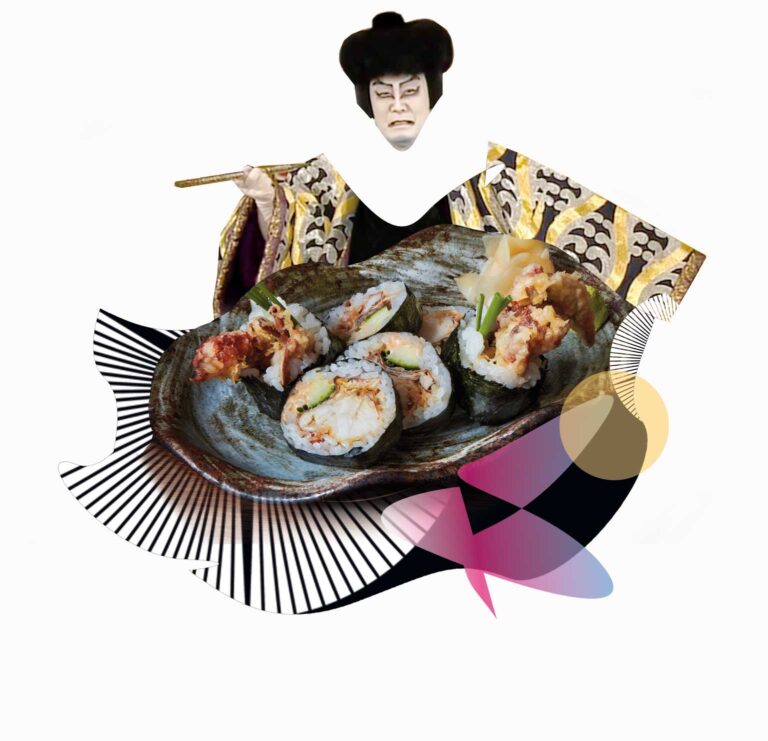
Sushi preparation
How do you actually do that?
Sushi seems to be available on every corner these days. But only chefs with extensive training in Japanese cuisine know what it should really taste like (really true - we have been experiencing this for 20 years in Munich over and over again).
The preparation of sushi is an art that the sushi chef has been perfecting all his life. There is always something new to learn. The deep understanding, knowledge and skill you do not get from books and cooking classes. It requires an intensive, long and always new occupation with the matter.
Sushi needs elaborate preparation work
Experienced masters such as Yūri Yagawa say that the preparation of sushi consists of 90% preparation (Japanese: shikomi).
Before the first roll can be rolled or the first nigiri can be formed, a lot more work is needed. Every single piece is a handcrafted product. One notices the quality of the basic ingredients and the qualifications of the chef in these individual delicacies.
In terms of taste, it doesn't have much to do with supermarket sushi, which is usually made with the help of machines. On the outside, it might look like a high-quality dish, but it is just a pale reflection that cannot convey the true flavor.
Use Sushi Master Special knives for the preparation of your creations. In our blog article on Japanese knives and sheathing techniques, we explain how you can recognize genuine Japanese knives and much more.
Season correctly
The basis for good sushi is properly seasoned rice. Mild rice vinegar, fish and rice combine to form a harmonious whole. If wasabi is needed, it is already included in the sushi. Also Soy sauce is basically only a small accent, so should be used very carefully and moderately. Consider the soy sauce as the icing on the cake, even in terms of quantity.
In very good sushi restaurants (for example, Japanese omakase restaurants), the traditional dish fully seasoned to the guest. Good sushi is never dry or boring per se, even without a special sauce.
Many restaurants outside of Japan use intense tasting sauces, lots of salmon and avocado, or even lots of deep-fried ingredients. There is a simple reason for this: such flavor-intensive creations can be used to mask the taste of the rice. This is possibly where the lack of training is concealed.
The authentic Japanese cuisine emphasizes the individual taste of the ingredients and avoids mixing flavours too much, instead allowing them to complement each other. Although culinary herbs are less common in Japan than elsewhere, they play an important role and are usually found exclusively there.
You can find out which herbs Japanese cuisine cannot do without in our info article on Japanese kitchen herbs.

Recognize quality
The inconspicuous traditional dish Sushi involves much more material than other culinary traditions.
Even Fine Dining often requires less effort. This means that really well-made sushi with high-quality ingredients is actually more with the effort and cost structure comparable to star gastronomy.
The production requires a lot of manual labor
The manual work, the long training and the high craftsmanship are in the foreground, both in preparation work and in the final preparation.
Due to the high time commitment, a sushi chef can only serve a few guests at a time. The personnel requirement is therefore also much higher than, for example, when preparing pizza or steak, pasta or gyros, ramen or udon.
For all those who want to delve deeper into the subject: In our detailed article on the ingredients of sushi, you will find a historical overview of the various side dishes and ingredients of sushi.
Good quality - not just a question of hygiene
Good sushi makes the intensive occupation with the raw ingredients, the long expertise and the meditative concentration on the essentials in the preparation of the ingredients tangible. Especially the latter is also a typical characteristic of Japanese culture.
The Rice is a crucial basic ingredient. It must be handled correctly and, above all, selected correctly. Hygienic quality is usually not a problem in Germany these days - the Culinary quality is a completely different matter, which laymen (and even professionals) often find difficult to understand.
Also the used Fish and its treatment is important for the quality of the sushi. Fish is an expensive raw material. The use of fish requires every step from the preparation to the actual preparation A lot of work. And this can only be done to the required quality by hand. Craftsmanship has its price!
That's why Japanese rice rolls with excellent quality ingredients, prepared by an experienced chef, can easily cost 50-100 euros per person in a casual restaurant, and 200 to 300 euros in particularly exclusive restaurants.
How do you recognize good Japanese restaurants? You can read the detailed answer to this in our article "Recognizing good Japanese restaurants".
Caution: Hot and greasy!
The more deep-fried sushi is offered, mayonnaise and intense-tasting sauces are used, the more likely the quality of the basic ingredients is not right.
Anything that masks the taste of rice, excessive use of strong tasting fish such as salmon and tuna, and also avocado indicate deficiencies elsewhere.
So if the menu focuses almost exclusively on salmon, tuna, avocado and brags about great sauces, then suspicion is in order.
Sushi on dry ice
Have you ever seen anything like it? Sushi and sashimi on dry ice, a new trend in Japanese restaurants in Munich that conceals more than it elevates. For connoisseurs Negative example for complete lack of understanding of Japanese cuisine - Fittingly, there is even a pizza in the back right of this stock photo.
Sushi & sashimi are sometimes served on dry ice. What's it all about? Find out more about this new trend in our blog article.

Our tip: Recognize good quality
Try a simple cucumber roll, the professional will immediately recognize whether it tastes good - without fancy sauces and wild fish combinations.
Another point is the appearance: the shape of nigiri in particular immediately reveals good craftsmanship and high-quality work.
Where can you find good sushi in Munich? Our impressions of Japanese and pseudo-Japanese restaurants in Munich:

Sushi etiquette
How, where and what do you eat with sushi?
Chopsticks or no chopsticks?
Sushi can and may with your fingers eat. The Japanese, especially sushi masters, even like to eat it with their hands. Because that's how the perfect experience very immediately noticeable on the palate.
If you don't want to eat with your fingers, use Chopsticks. The Japanese bamboo sticks are tasteless and are ideal for this! Western cutlery is best avoided as it is not part of Japanese cuisine and is also harmful to Japanese tableware.
Too big for a bite
By the way, if the sushi pieces are too big for a bite, this usually indicates little knowledge and skill on the part of the cooks. The fact that the individual bites are bite-sized for the guest is already an absolutely fundamental characteristic of sushi. Moritsuke, the Japanese art of dressing.
The only exceptions are futomaki and temaki. They can be too big to fit in the mouth at once.
No gos when eating shushi
If you ask Japanese people how to eat sushi better, the answer usually doesn't help: "Eat it the way you want and it tastes best!"
However, there are some customs in Japan, in the seriousness somewhere between experience value and rule.
Rub your chopsticks before the meal not loudly to each other. This signals: The chopsticks are not good enough and especially not free of splinters. But in a good restaurant you can get splinter-free bamboo chopsticks.
Gariginger, which has an intense flavor, should be under no circumstances top to the finely prepared Sushi pieces be placed! The order of the different types, the handling of wasabi and soy sauce and the like is also more or less regulated in Japan (depending on the region).
Read more about sushi etiquette and how to eat it according to tradition in our blog article "How to eat sushi".
What can you serve with sushi?

Supplements
You don't eat anything with sushi. Sushi is not a side dish or a main course that has to be combined with side dishes - sushi is enough on its own. Soy sauce is used by sushi masters, Sushi & Sashimi seasoning. However, the sushi should never be soaked in soy sauce!
Are you interested in learning about the differences, production methods and origins of shōyu, the Japanese soy sauce? Then our info article about it is just the thing for you!
The Ginger, Gari is used to neutralize the taste between the individual sushi, similar to the piece of white bread that goes with a wine tasting. It is therefore not a side salad! That's what it's for, Edamame (salted soybean pods) to nibble on, perhaps a bowl of Miso soup which is usually served with a meal in Japan, not as an appetizer.
Japanese miso soup, also known as "misoshiru" and always found on the menu of sushi restaurants, is made by combining miso with a unique Japanese soup stock called dashi.
Find out more about the flavor carrier dashi and miso soup here.
And if you want to dine in a particularly feudal manner, you might want to treat yourself to a fine Sashimi.
To round things off, German palates can also enjoy a Dessert if you are lucky enough to be sitting in a restaurant with homemade desserts.
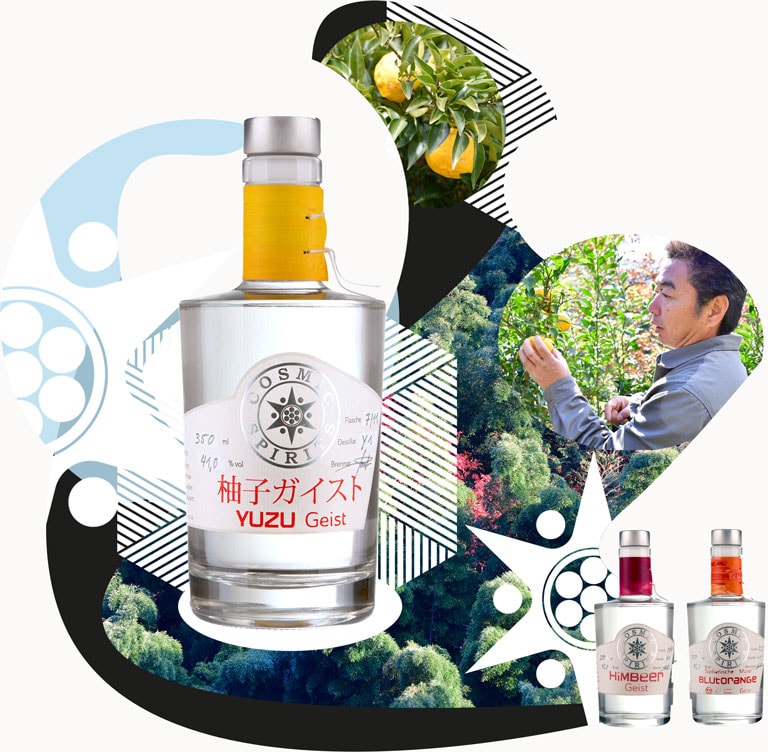
Drinks
Beer is extremely popular in Japan. However, the restaurants at the top end of the scale in Japan only serve a bowl of green tea after finishing the meal.
You can find a small guide to what to drink with sushi here:
Depending on the restaurant, finer SakeJapanese rice wine. Good, high-quality sake is far more than just an alcoholic drink. It is an expression of the Japanese soul and its unique culture. However, a suitable German wine (Riesling, for example) can also go well with sushi.
You can find out everything you need to know about Japanese rice wine here:
Where do you eat sushi?
Sushi is often understood as fast food. Let's take the term literally (fast = fast), then it comes out somehow - the small rice bites can be eaten quite quickly.
If, on the other hand, fast food is understood to be low quality and quickly prepared, then Japanese food is certainly not fast food. It is not considered fast food in Japan either. There are numerous other forms of fast food here (most popularly the well-known noodle soups), but that is another topic.

In Japan
The classic way to eat sushi in Japan is often in a Sushi bar. The guest sits opposite the chef. The rice canapés are considered something very special and are celebrated accordingly.
Japanese sushi restaurants follow strict labels: guests wait to be seated, prefer counter seating and use oshibori cloths. The sushi is served in a specific order. Separate payment is unusual. SUSHIYA's Restaurant sansaro in Munich offers authentic Japanese dining experiences.
Discover the secrets of a typical visit to a Japanese restaurant - read our detailed report now!
In addition, as in this country, there are all kinds of Supermarket sushi up to the Delivery service. One thing sushi is certainly not in Japan is a simple, cheap everyday snack. Even the cheaper kaiten zushis (restaurants where the snacks are delivered to the table on a conveyor belt) are more expensive than a teishoku (restaurant where you order from the menu) or Japanese fast food restaurants serving ramen, yakitori or soba.
Discover Japan's culinary diversity! Our article "Types of restaurants in Japan" takes you through the fascinating world of Japanese restaurants - far beyond sushi.

In Germany
Classic Japanese sushi bars are rarely found in Germany. This is because awareness of the culinary arts is less pronounced in this country.
In Germany, the budget for food is rather low anyway, even compared to other European countries. Therefore, in Germany in restaurants often Sushi with other Asian cuisine mixed together. This can be good, it can be bad - in any case, you should pay very close attention to the philosophy of the restaurant, especially when it comes to Japanese rolls.
Eating sushi in Munich
When you try sushi for the first time, you should go to the highest quality Japanese restaurant possible. This will guarantee that you get the right impression of the taste right away.
Restaurant sansaro Munich
Since 2007, the organic and SlowFood-certified restaurant sansaro in Munich attaches great importance to high product quality and craftsmanship.
The restaurant sansaro was completed in summer 2022 with a "Assiette" awarded in the MICHELIN Guide. In the same year, we received the Gourmet guide Gusto five pans for our authentic Japanese cuisine and the above-average level of sushi.
Would you like to have high-quality sushi delivered to an event? SUSHIYA sansaro has been offering high-quality, authentic Japanese catering in Munich since 2007. Ideal for corporate events, functions or private parties. Find out more now:

Is sushi healthy?
Sushi from a health point of view
The japanese cuisine is considered one of the healthiest in the world. There are of course reasons why the Japanese have one of the highest life expectancies in the world. Is it because people in Japan eat sushi every day? No, because that is not the case. The Japanese rice snacks with fish and/or vegetables are also something special in Japan and not an everyday snack.
But how healthy is sushi? Nutrition experts consider sushi according to different criteria than restaurant visitors. Find out more in our article "Is sushi healthy? - Everything you need to know about maki, nigiri & co in terms of nutritional psychology".
Who is not allowed to eat sushi?
In principle, the popular rice snack is of course healthy, provided it is prepared correctly and expertly. But there are a few restrictions that you should be aware of.
In Germany, the advice is Pregnant womento avoid raw fish. This has nothing to do with the fish itself, but with any pathogens it may contain and the sometimes quite high levels of heavy metals. In Japan, however, pregnant women eat sashimi as a matter of course. The quality controls ensure that the fish is safe.
Those who participate in the Autoimmune disease coeliac disease should avoid soy sauce. Soy sauce contains wheat. Instead, you can season your sushi with tamari, a wheat-free and therefore gluten-free soy sauce. You don't have to give up sushi completely!
Graves' disease and Hashimoto's are just two diseases associated with the Thyroid gland associated diseases. Hypo- and hyperthyroidism are widespread in Germany. Anyone suffering from such a condition should consume less nori. This is because nori, the seaweed leaves, contain extremely high levels of iodine, which can really mess up the metabolism. However, there is nothing to stop you from enjoying nigirizushi without nori!
As a general rule, you should of course only enjoy sushi and especially sashimi where No doubt about the freshness and quality of the ingredients. If the sushi is very inexpensive, however, convenience products and mass-farmed fish are probably used to prepare it.
Note: A high price is no guarantee of high quality. Conversely, high quality always has its price.
Fresh sushi - nothing else!
Basically, if the restaurant attaches importance to high-quality fish, to the artisanal production and Organic qualitythen the Japanese specialty can be very healthy. This is because carefully selected and prepared ingredients have a higher nutritional value and lower exposure to harmful substances, and fewer additives are used.
In our experience, however, the use of organic quality ingredients in German restaurants is a rare exception when you talk about some persuaders and star gastronomy.
In our starred restaurant sansaro in the heart of Munich, we serve first-class sushi and many other exquisite Japanese dishes. We also have a large selection of sake, Japanese rice wine and traditional side dishes for you.

How much does sushi cost?
Is sushi expensive?
Sushi is not a quick, cheap meal - and it shouldn't be!
The reason is simple: the best-known ingredients for rice canapés are not cheap. Fish suitable for raw consumption is expensive to procure. Even good japonica rice has its price. But what drives up the cost, apart from good rice and fresh fish, is the elaborate and expert preparation by experienced professionals.
Sushi chefs always start with the whole fish. It is scraped and gutted, filleted and then processed into so-called saku. Only the best pieces of fish are used, and they must be prepared in many individual steps.
Curious? We have an example:
For the seemingly simple prawn sushi (ebi), the prawns have to be individually threaded onto bamboo skewers. They are cooked in this way and then allowed to cool. The shell is then removed. The prawns can then be cut into the appropriate shape. Only then can the chef prepare the prepared rice with the prawns and any other ingredients to make Ebi nigiri or another type of nigiri for you.
Of course, such shrimp are also available from the plastic package as far as possible prepared - but you will find this in good japanese Sushi restaurants rarely find.
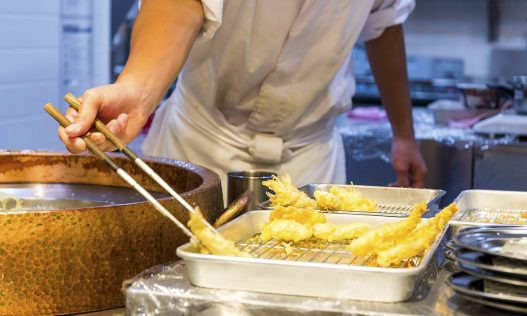
Elaborate preparatory work
Japanese chefs like Master Yagawa say that the preparation of sushi to 90% consists of preparation (jap: shikomi).
Before the first roll can be rolled or the first nigiri can be formed, a lot more work is needed. Every single piece is a handcrafted product. One notices the quality of the basic ingredients and the qualifications of the chef in these individual delicacies.
In terms of taste, it doesn't have much to do with supermarket sushi, which is usually made with the help of machines. On the outside, it might look like a high-quality dish, but it is just a pale reflection that cannot convey the true flavor.
The cost depends on the shape and variety
And how much sushi do you need to get full? Do you concentrate on maki or do you enjoy nigiri? The composition of the appetizers, vegetarian or with fish, also plays a role.
As a rough guide, you can say that vegetarian options can fill you up for around 30 euros, with fish and other ingredients it will be at least 40 euros or more. Lots of fish, nigiri and very high quality drive up the cost, which can be as much as 100 euros per person (as at the end of 2021).
It is better to avoid low-cost offers! For 16 euros, you will only be full if the quality of the raw materials remains at a low level. And with sushi, that usually means: almost Toxic bredsalmon and convenience products, which are Stomach filler serve. 20 Euro for "all you can eat" are a waste of money in our opinion when it comes to sushi. The traditional dish is only so cheap if extremely inexpensive ingredients are purchased and savings are made on staff.
You don't get the best ingredients everywhere
How expensive such a culinary and cultural indulgence program becomes, however, depends on other factors as well: In some cities, ingredients are easier to procure than in others, which has to do with transportation routes and supply chains. On the other hand, in a city like Tōkyō, Paris, Munich or London, the personnel costs are correspondingly higher, as the kitchen staff need much more money for rent than in Nuremberg, Shizuoka or Graz.
Conclusion: Good sushi must be cost-intensive!

Conclusion
Sushi - a very special treat
Sushi is always a special treat.
For many in the West, it's a kind of sylish fun food these days, as the little rolls are easy to consume. But this is not sushi. Also important to know: The restaurants that rely on superficial show effects (eg. Sushi presentation with dry ice), are often just not qualified sushi restaurants.
Sushi is not a show, but artful & painstaking craft.
Really good sushi to produce is a real challenge - and not only in the short term, but also in the medium and long term. This cannot be done without precision, discipline and elaborate preparation.
For a chef, sushi is an incredibly exciting subject because it presents a lifetime of challenges - at least if the diner gets involved and follows the chef in his or her experiences and search for seasonal, high-quality material. In the preparation, the Sideboards, the different combinations and serving the delicate ingredients, you always learn something new and deepen your knowledge, perfecting the craft continuously.
Above all, good sushi stands in the comprehensive tradition and world of Washoku, the Japanese cuisine. It is often copied abroad, but it is rarely done well. When you taste really good Japanese cuisine, it usually (at least for Japan connoisseurs, we don't know now if other people always feel the same way) creates a kind of happiness, joy, inner warmth.
That's how it should be: good food should make you happy, not just full. That's why it's always worth getting involved with authentic Japanese cuisine.
More about Japanese cuisine?
Follow
Japan Keeping an eye on sushi, sashimi & fine Japanese cuisine rare outside Japan. Follow us on
Employees wanted
Japanese cuisine with ambition in Munich Are you professionally interested in good Japanese cuisine? Then apply now without cover letter
Chōmiryō – Eine Reise durch Japans Würzmittel (調味料)
In der japanischen Küche gehören 調味料 (chōmiryō) – auf Deutsch „Würzmittel“ oder „Würzzutaten“ – zu den wichtigsten Elementen, um den
